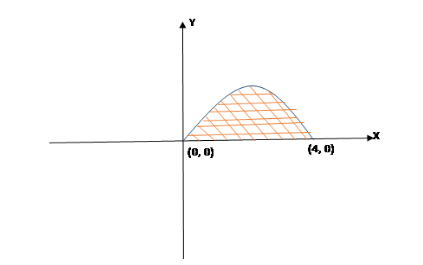
The area bounded by the curve \[y = 4x - {x^2} \] and the X-axis, is
A. \[ \dfrac{{32}}{3} \] sq.unit
B. \[ \dfrac{{31}}{7} \] sq.unit
C. \[ \dfrac{{32}}{7} \] sq.unit
D. \[ \dfrac{{34}}{3} \] sq.unit
Answer
554.7k+ views
Hint: We apply the application of integrals to find the area of the given curve and axis. Equation of X-axis is given by \[y = 0 \] . By using the given curve and equation of X-axis we find the limits of the integration. Solving the obtained definite integral we obtained the required area of the given region. We can represent the above region in a plane.
Complete step-by-step answer:
Given, the curve \[y = 4x - {x^2} \] ---- (1)
As we know the equation of X-axis is \[y = 0 \] ----- (2)
Substituting equation (2) in equation (1) we get,
\[y = 4x - {x^2} \]
\[ \Rightarrow 4x - {x^2} = 0 \]
\[ \Rightarrow x(4 - x) = 0 \] (Using zero product property)
\[ \Rightarrow x = 0 \] and \[x = 4 \] .
Using this we draw a diagram to show the region bounded by the curve.

The curve cuts the X-axis at (0, 0) and (4, 0).
So we can see that the limit of x is from 0 to 4.
Hence the required area in the interval [0, 4] is \[ \int \limits_0^4 {ydx} \] .
\[ \Rightarrow \int \limits_0^4 {(4x - {x^2})dx} \]
Split the integral,
\[ \Rightarrow \int \limits_0^4 {4xdx - \int \limits_0^4 {{x^2}dx} } \]
Take constant outside the integral,
\[ \Rightarrow 4 \int \limits_0^4 {xdx - \int \limits_0^4 {{x^2}dx} } \]
Integrate with respect to x.
\[ \Rightarrow = 4 \left[ { \dfrac{{{x^2}}}{2}} \right] _0^4 - \left[ { \dfrac{{{x^3}}}{3}} \right] _0^4 \]
Applying lower and upper limits,
\[ \Rightarrow \dfrac{4}{2}[{4^2} - 0] - \dfrac{1}{3}[{4^3} - 0] \]
\[ \Rightarrow \dfrac{4}{2}[16 - 0] - \dfrac{1}{3}[64 - 0] \]
\[ \Rightarrow 32 - \dfrac{{64}}{3} \]
\[ \Rightarrow \dfrac{{96 - 64}}{3} \]
\[ \Rightarrow \dfrac{{32}}{3} \] sq.uint.
Hence, the area bounded by the curve \[y = 4x - {x^2} \] and the X-axis, is \[ \dfrac{{32}}{3} \] sq.unit.
So, the correct answer is “Option A”.
Note: Remember that the equation of X-axis is given by \[y = 0 \] . The equation of Y-axis is given by \[x = 0 \] . Using the given curve or any equation we find the limits and afterwards we solve it. In the definite integral the integration constant cancels out. Similarly we can find the area bounded by the curves, parabola, circles etc.… In all cases the method is the same as above.
Complete step-by-step answer:
Given, the curve \[y = 4x - {x^2} \] ---- (1)
As we know the equation of X-axis is \[y = 0 \] ----- (2)
Substituting equation (2) in equation (1) we get,
\[y = 4x - {x^2} \]
\[ \Rightarrow 4x - {x^2} = 0 \]
\[ \Rightarrow x(4 - x) = 0 \] (Using zero product property)
\[ \Rightarrow x = 0 \] and \[x = 4 \] .
Using this we draw a diagram to show the region bounded by the curve.

The curve cuts the X-axis at (0, 0) and (4, 0).
So we can see that the limit of x is from 0 to 4.
Hence the required area in the interval [0, 4] is \[ \int \limits_0^4 {ydx} \] .
\[ \Rightarrow \int \limits_0^4 {(4x - {x^2})dx} \]
Split the integral,
\[ \Rightarrow \int \limits_0^4 {4xdx - \int \limits_0^4 {{x^2}dx} } \]
Take constant outside the integral,
\[ \Rightarrow 4 \int \limits_0^4 {xdx - \int \limits_0^4 {{x^2}dx} } \]
Integrate with respect to x.
\[ \Rightarrow = 4 \left[ { \dfrac{{{x^2}}}{2}} \right] _0^4 - \left[ { \dfrac{{{x^3}}}{3}} \right] _0^4 \]
Applying lower and upper limits,
\[ \Rightarrow \dfrac{4}{2}[{4^2} - 0] - \dfrac{1}{3}[{4^3} - 0] \]
\[ \Rightarrow \dfrac{4}{2}[16 - 0] - \dfrac{1}{3}[64 - 0] \]
\[ \Rightarrow 32 - \dfrac{{64}}{3} \]
\[ \Rightarrow \dfrac{{96 - 64}}{3} \]
\[ \Rightarrow \dfrac{{32}}{3} \] sq.uint.
Hence, the area bounded by the curve \[y = 4x - {x^2} \] and the X-axis, is \[ \dfrac{{32}}{3} \] sq.unit.
So, the correct answer is “Option A”.
Note: Remember that the equation of X-axis is given by \[y = 0 \] . The equation of Y-axis is given by \[x = 0 \] . Using the given curve or any equation we find the limits and afterwards we solve it. In the definite integral the integration constant cancels out. Similarly we can find the area bounded by the curves, parabola, circles etc.… In all cases the method is the same as above.
Recently Updated Pages
A man running at a speed 5 ms is viewed in the side class 12 physics CBSE

The number of solutions in x in 02pi for which sqrt class 12 maths CBSE

State and explain Hardy Weinbergs Principle class 12 biology CBSE

Write any two methods of preparation of phenol Give class 12 chemistry CBSE

Which of the following statements is wrong a Amnion class 12 biology CBSE

Differentiate between action potential and resting class 12 biology CBSE

Trending doubts
What are the major means of transport Explain each class 12 social science CBSE

Which are the Top 10 Largest Countries of the World?

Draw a labelled sketch of the human eye class 12 physics CBSE

How much time does it take to bleed after eating p class 12 biology CBSE

Explain sex determination in humans with line diag class 12 biology CBSE

When was the first election held in India a 194748 class 12 sst CBSE




